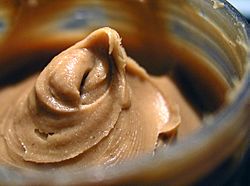Nut butter facts for kids

Peanut butter
|
|
| Type | Spread |
|---|---|
| Main ingredients | Nuts |
A nut butter is a yummy, spreadable food. It's made by grinding nuts into a smooth paste. This paste has a lot of healthy fats. You can spread it just like real butter, but it's not actually made from milk.
Many different kinds of nut butters exist. Some popular ones include:
- Acorn butter
- Almond butter
- Cashew butter
- Hazelnut butter
- Macadamia nut butter
- Peanut butter
- Pecan butter
- Pistachio butter
- Walnut butter
You might be surprised to learn that some of these, like almonds, cashews, and peanuts, aren't "true nuts" in a scientific way. But because we use them like nuts in cooking, their spreads are still called nut butters!
Contents
Seed Butters: A Close Cousin
Similar spreads can also be made from seeds. These are usually not called nuts at all. Some examples are:
- Pumpkin seed butter
- Sesame seed butter (often called tahini)
- Soybean butter – made from soynuts (which are roasted soybeans)
- Sunflower seed butter
- Hummus or chickpea spread (made from chickpeas, which are legumes, not nuts or seeds)
Why Nut and Seed Butters Are Good For You
Nut and seed butters are packed with good stuff! They have a lot of protein, which helps your body grow strong. They also contain fiber, which is good for your digestion. Plus, they have essential fatty acids, which are healthy fats your body needs.
You can use nut butters in many ways. They are great instead of butter or margarine on bread or toast. They also make tasty dipping sauces for fruits like apples and bananas. You can add them to oatmeal or smoothie bowls for extra flavor and nutrients. Some Asian sauces even use them as a key ingredient!
A Look Back in Time
Grinding nuts into a paste is not a new idea. People have been doing it for a very long time!
Long ago, Almond paste or marzipan was a special treat. The caliphs (rulers) of Baghdad loved it. A cookbook from the 800s, called the Kitab al-Tabikh, describes a sweet almond paste called lauziinaq. It was very similar to marzipan.
Later, during wars like the Napoleonic wars and World War II, there were shortages of certain foods. Hazelnut butter was mixed with chocolate to help with this. This clever idea led to the invention of gianduja chocolate spreads. One famous example you might know is Nutella!
Nutritional Facts
Nut and seed butters offer different amounts of nutrients. The table below shows some approximate facts for a small serving (about 1 tablespoon or 15 grams). Keep in mind that some nut butters have added oils or other ingredients. These can change their nutritional content.
| Butter | Food energy kJ (kcal) |
Protein (g) |
Fat (g) |
Calcium (mg) |
Zinc (mg) |
|---|---|---|---|---|---|
| Almond butter | 101 (420) | 2.4 | 9.5 | 43 | 0.5 |
| Cashew butter | 93 (390) | 2.8 | 8 | 7 | 0.8 |
| Hazelnut butter | 94 (390) | 2 | 9.5 | N/A | N/A |
| Peanut butter – natural | 94 (390) | 3.8 | 8 | 7 | 0.4 |
| Peanut butter – reduced fat | 95 (400) | 4 | 6 | N/A | 0.4 |
| Sunflower butter | 80 (330) | 3 | 7 | N/A | N/A |
| Soy butter (sweetened) | 85 (360) | 4 | 5.5 | 50 | N/A |
| Soy butter (unsweetened) | 80 (330) | 4 | 6.5 | 30 | N/A |
| Soy-peanut butter (added sweetener) | 50 (210) | 2 | 1.2 | 40 | N/A |
| Tahini | 89 (370) | 2.6 | 8 | 64 | 0.7 |
See also
 In Spanish: Manteca de frutos secos para niños
In Spanish: Manteca de frutos secos para niños
pl:Masło orzechowe

